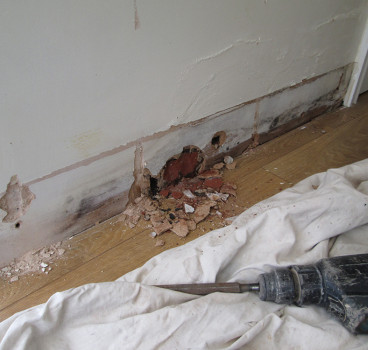How Bluetooth technology is helping to transform construction
Bluetooth technology has emerged as a transformative force in the construction industry, enhancing efficiency, safety and connectivity on job sites worldwide. From advanced tool tracking to real-time data sharing, Bluetooth's integration into construction practices is revolutionising how projects are managed and executed – and the future for this technology looks very promising indeed – writes John Ridgeway.
The construction sector has historically been slow to embrace new technologies. However, the advent of the Internet of Things (IoT) and the need for more efficient project management have spurred the integration of Bluetooth-enabled devices on construction sites worldwide. According to a report by MarkWide Research, the industrial Bluetooth market is projected to reach $8.5 billion by 2028, with a compound annual growth rate (CAGR) of 8.1% from 2023 to 2028 – so the potential is massive.
In North America and Europe, regions with advanced industrial infrastructures, Bluetooth technology is being used to streamline operations and enhance safety protocols. The Asia-Pacific region, experiencing rapid industrialisation, is also witnessing significant growth in Bluetooth adoption within the construction sector. Countries like China and India are leveraging Bluetooth for asset tracking and equipment maintenance, contributing to increased efficiency on construction sites.
Bluetooth Low Energy (BLE) beacons are now being employed to monitor the location and status of tools and equipment in real-time. This reduces the time spent searching for assets and minimises losses due to theft or misplacement. For instance, attaching BLE tags to machinery allows site managers to track these assets and provide more efficient maintenance schedules.
Wearable devices equipped with Bluetooth technology can monitor workers' vital signs and environmental conditions. In hazardous situations, these devices can send alerts to supervisors, enabling prompt responses to potential safety incidents. Additionally, Bluetooth-enabled proximity sensors can prevent accidents by alerting workers when they are too close to dangerous equipment or restricted areas.
Bluetooth also allows for seamless data transfer between devices on construction sites. For example, sensors embedded in concrete can transmit data about curing temperatures and humidity levels to mobile devices, ensuring quality control. Furthermore, Bluetooth-enabled devices allow for efficient communication among team members, even in areas with limited cellular connectivity.
BIM integration
Integrating Bluetooth technology with BIM enables real-time updates to digital models based on on-site activities. This ensures that all stakeholders have access to the most current project information, enabling better decision-making and reducing errors.
However, despite its advantages, implementing Bluetooth technology in construction faces several challenges such as interference and connectivity issues. Construction sites are dynamic environments with numerous potential sources of signal interference, which can affect Bluetooth connectivity and data accuracy.

Many Bluetooth devices also rely on battery power and frequent replacements or recharging can be impractical on large sites. In addition, transmitting sensitive project information over Bluetooth can pose security risks if not properly encrypted and managed.
In spite of this, the future of Bluetooth technology in construction is promising, with several trends indicating increased adoption and innovation. The development of Bluetooth 5.0 and beyond offers extended range, faster data transfer rates and improved reliability, making it more suitable for large-scale construction projects. These advancements will enhance the effectiveness of Bluetooth applications in asset tracking, safety monitoring and data communication.
Combining Bluetooth with other technologies like Artificial Intelligence (AI) and Augmented Reality (AR) can also revolutionise construction processes. For instance, AI algorithms can analyse data collected via Bluetooth devices to predict equipment failures, while AR applications can provide workers with real-time, Bluetooth-enabled visual instructions on-site.
As the IoT ecosystem in construction expands, Bluetooth will play a crucial role in connecting various devices and systems. This interconnectedness will lead to smarter construction sites, where data-driven insights optimise operations and resource management.
Furthermore, Bluetooth technology can contribute to more sustainable construction practices. For example, monitoring energy consumption of equipment via Bluetooth sensors can help in implementing energy-saving measures, thereby reducing the environmental impact of construction activities.
When all of this is considered, there can be no doubt that Bluetooth technology is transforming the construction industry by providing efficient solutions for asset management, safety monitoring and data communication. Its global adoption is on the rise, driven by advancements in IoT and the need for more streamlined construction processes. As technology continues to evolve, Bluetooth is poised to play an integral role in shaping the future pf construction leading to smarter, safer and more efficient building practices worldwide.
Additional Blogs

How construction can cut Its carbon footprint by caring for soil
Soil is often dismissed as mere dirt, but it is one of the planet’s most powerful carbon stores, holding more than all of the world’s forests combined. Yet in our rush to build, pave and develop, we...
Read moreWhat is bridging damp? How it happens and how to fix it
Bridging damp happens when moisture finds a path around the building’s damp-proof course (DPC) so it reaches your internal walls and skirting. If you see damp patches rising above the skirting or...
Read more

The silent death of the fixed-price contract
For decades, the fixed-price contract has been the backbone of construction procurement. It promised certainty with a defined scope, an agreed sum and a clear transfer of risk from client to...
Read more